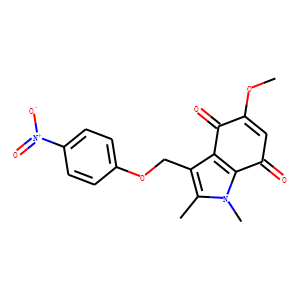| Reference | 1. Chem Biol Interact. 2010 Jul 30;186(2):174-83. doi: 10.1016/j.cbi.2010.04.022.
Epub 2010 Apr 28.
<br>
ES936 stimulates DNA synthesis in HeLa cells independently on NAD(P)H:quinone
oxidoreductase 1 inhibition, through a mechanism involving p38 MAPK.
<br>
González-Aragón D(1), Alcaín FJ, Ariza J, Jódar L, Barbarroja N, López-Pedrera C,
Villalba JM.
<br>
Author information: <br>
(1)Departamento de Biología Celular, Fisiología e Inmunología, Facultad de
Ciencias, Universidad de Córdoba, Spain.
<br>
The indolequinone ES936
(5-methoxy-1,2-dimethyl-3-[(4-nitrophenol)methyl]-indole-4,7-dione) is a potent
mechanism-based inhibitor of NAD(P)H:quinone oxidoreductase 1 (NQO1). Here, we
report that ES936 significantly stimulated thymidine incorporation in sparse
cultures of human adenocarcinoma HeLa cells, but was without effect in dense
cultures. Stimulation of DNA synthesis was not related with a DNA repair response
because an increase in thymidine incorporation was not observed in cells treated
with 2,5 bis-[1-aziridyl]-1,4 benzoquinone, a well-established antitumor quinone
that causes DNA damage. Conversely, it was related with an increase of cell
growth. NQO1 inhibition was not involved in ES936 stimulation of DNA synthesis,
because the same response was observed in cells where NQO1 expression had been
knocked down by small interfering RNA. Stimulation of DNA synthesis was reverted
by treatment with ambroxol, a SOD mimetic, and by pyruvate, an efficient peroxide
scavenger, supporting the involvement of alterations in cellular redox state.
Pharmacological inhibition of p38 with either SB203580 or PD169316 completely
abolished ES936-stimulated DNA synthesis, indicating the requirement of p38
activity. This is the first report that demonstrates the existence of an
ES936-sensitive system which is separate from NQO1, modulating the redox state
and cell growth in HeLa cells through a p38-dependent mechanism. Our results show
that the effect ES936 exerts on DNA synthesis may be either positive or negative
depending on the cellular context and growth conditions.
<br><br>
2. Mol Pharmacol. 2003 Sep;64(3):714-20.
<br>
Biochemical, cytotoxic, and genotoxic effects of ES936, a mechanism-based
inhibitor of NAD(P)H:quinone oxidoreductase 1, in cellular systems.
<br>
Dehn DL(1), Siegel D, Swann E, Moody CJ, Ross D.
<br>
Author information: <br>
(1)Department of Pharmaceutical Sciences, Campus Box C238, University of Colorado
Health Sciences Center, 4200 East Ninth Avenue, Denver, CO 80262, USA.
<br>
The specific involvement of NAD(P)H:quinone oxidoreductase 1 (NQO1) in the
bioactivation of quinone prodrugs has been shown through the use of the inhibitor
of NQO1, dicoumarol. Disadvantages of using dicoumarol to inhibit NQO1 include
its lack of specificity and its competitive mechanism of inhibition. The
concentration of dicoumarol required for inhibition of NQO1 varies according to
the substrate under evaluation, which may lead to either false conclusions of the
involvement of NQO1 or the alteration of other cellular processes. We have
reported previously on the chemical and biochemical properties of ES936, a
mechanism-based inhibitor of NQO1 in cell-free systems. In this study, we
investigated the effects of ES936 in cellular systems. ES936 (100 nM) inhibits
more than 95% of NQO1 activity within 30 min and is stable in complete media at
this concentration for a minimum of 2 h. The duration of inhibition is cell
line-specific because a new protein must be generated for resumption of activity.
ES936 abrogates the toxicity of streptonigrin, with greater effects seen in cell
lines expressing higher levels of NQO1. ES936 does not inhibit other cellular
reductases, nor does it alter cellular levels of acid-soluble thiols. Some
evidence of DNA strand breaks was observed at the concentrations of ES936
required for the inhibition of NQO1 activity. From our studies, we propose the
use of ES936 (100 nM) as a mechanism-based inhibitor of NQO1 in cellular systems
and for use as a component of the routine activity assay for NQO1.
<br>
|

